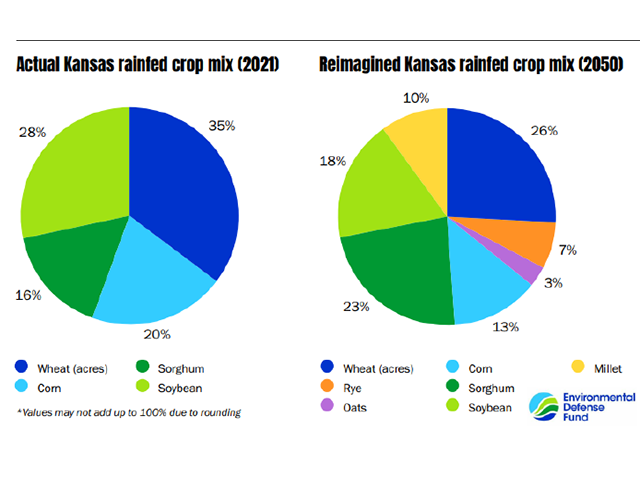Ag Weather Forum
Climate Change Study Calls for More Variety in Kansas Crop Mix
Future crops in Kansas will have to include more drought-tolerant grains like those of sub-Saharan Africa to adapt to climate change. That's the bottom line of a recent study done by the Environmental Defense Fund (EDF).
The EDF Kansas research is a follow-up to a larger project the organization did in 2022 which focused on how ever-warmer weather and more-frequent drought will affect total U.S. crop production by 2050 -- less than 30 years away.
However, that 2050 future may be here now. The EDF report's lead scientist, Eileen McLellan, told DTN that she was working on the Kansas research when the 2023 wheat harvest results were posted, and was astonished at the news. "We started to see news items about the wheat harvest. And it was devastating" she said. "Wheat (Kansas production) was down about 40% from a typical year and the lowest Kansas wheat harvest in about 60 years. That decline was due to high temperatures but even more importantly to drought. We were astonished that here was a problem --warmer, drier, crops would fail, and this was happening in real time before the report was even published." Her comments are borne out in Kansas ag statistics. The Kansas wheat crop in 2023 totaled 201 million bushels, the smallest since 1960.
A major conclusion from the EDF study is that crop acreage, now dominated by corn, soybeans and wheat, needs to be much more varied in order to produce the same amount of food with less water and higher temperatures.
P[L1] D[0x0] M[300x250] OOP[F] ADUNIT[] T[]
"If farmers introduced more of these into rotation there will still be same levels of nutrition, water requirement would be reduced, and not the decline in yield because of the higher temperatures."
The EDF study suggests that the Kansas rainfed crop mix in 2050 needs to show much more variety than it does now in order to adapt to climate change. Wheat and soybean acreage would shrink by about 10% and corn acreage would crop by 7%. Sorghum, known for drought tolerance, would see a 10% increase in acreage. And 20% of the Kansas crop acreage would be planted to millet, rye and oats, with millet getting a full 10% of the state's rainfed crop acreage. The most millet acreage would be in central and eastern Kansas in the EDF findings.
This crop mix change would easily place Kansas as the top state for millet production and would vault the U.S. into the Top 10 for millet production worldwide. In 2023, the top producing nations in millet production were: India, China, Niger, Nigeria, Sudan, Mali, Senegal, Ethiopia, Burkina Faso and Chad. The U.S. ranked 12th. But the level of production suggested by the EDF report would push the U.S. into the ninth-place position at 865,000 metric tons (mt) -- behind Ethiopia and ahead of Burkina Faso. Kansas would contribute more than half that total at 516,179 mt.
Allocating a substantial amount of land to crops that are not even thought about is a major issue in U.S. agriculture's climate change future. But EDF's Eileen McLellan said that producers know that, when it comes to climate, things are much different now than they used to be.
"Farming is going to be somewhere between a little and a lot different from what they're doing now," McLellan said.
The full EDF Kansas climate change adaptation report is available here:
Bryce Anderson can be reached at Bryce.Anderson@dtn.com
(c) Copyright 2024 DTN, LLC. All rights reserved.




